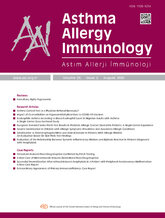


Objective: Eosinophilic asthma is increasingly being studied; however, its prevalence is largely unknown in sub-Saharan Africa. We aimed to determine the prevalence of eosinophilic asthma, defined in this study as a blood eosinophil count (BEC) of ≥ 300 cells/μL, among adults with asthma and its associated characteristics in a tertiary center in Nigeria.
Materials and Methods: A prospective cross-sectional study was conducted in a tertiary center on 77 consecutive adult patients aged ≥ 18 years with physician-diagnosed asthma (30% were males; the median (25th and 75th percentile) age and the duration of symptoms were 44 (29-59) years and 15 (8-29) years, respectively). Atopic status and lung function were assessed by the skin prick test and spirometry, respectively. Blood samples were collected for BEC, total Immunoglobulin E (IgE), and Interleukin 13 assays. Logistic regression was used to determine factors associated with BEC ≥ 300 cells/μL.
Results: Of the 77 asthma patients, 24 (31%; 95% Confidence Interval (CI); 21%–43%) had a BEC ≥ 300 cells/μL. Nineteen (25%; 95% CI 16%-36%) had both BEC ≥ 300 cells/μL and atopy overlap. Participants who had BEC of ≥300 cells/μL were more often male, had associated allergic rhinitis, and higher total IgE concentration. After adjusting for relevant cofactors, male sex and total IgE were associated with BEC of ≥300 cells/μL and atopy overlap with adjusted odds ratios of 2.27 (1.03-5.04) and 1.79 (1.14-2.81), respectively.
Conclusion: Eosinophilic asthma using BEC as a biomarker is moderately prevalent in Nigerian adult asthmatics with some characteristic clinical profiles. Adult asthmatics with these characteristics would need further evaluation and may also benefit from screening for other allergic diseases, in particular allergic rhinitis.